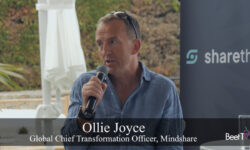CANNES — “Demanding a greener digital advertising industry is not only necessary, it’s already happening,” says Anthony Katsur, CEO of IAB Tech Lab.
In less than four months, the body’s sustainability working group has attracted nearly 90 company members dedicated to reducing carbon footprints and building a sustainable digital ad ecosystem.
In this video interview with Tameka Kee for Beet.TV, Katsur describes the mission.
Making Ad Impressions Greener
According to Katsur, one of the group’s achievements is the release of The Sustainability Playbook, a practical guide outlining steps to reduce carbon emissions in the industry. This guide is readily available and easily accessible on the IAB Tech Lab website.
One recommendation is the concept of “lazy load”. Katsur explains: “Lazy load is a concept of ‘don’t load the impression until the impression actually comes into view, don’t make an impression call’.” This method prevents unnecessary ad impression calls, which consume energy and consequently, burn carbon.
The advantage of this method, Katsur emphasizes, is that it is “literally a checkbox in the ad server” and doesn’t require much effort from publishers or advertisers. “There are millions, perhaps even billions of impressions that are still delivered… every time an impression is processed, that burns carbon.”
Check out IAB Tech Lab’s Sustainability Playbook as part of our continuous effort to assist the #DigitalAdvertising industry in reducing carbon emissions with #sustainable media best practices! https://t.co/TKHZjfCZLc pic.twitter.com/BLaco6L6sN
— IAB Tech Lab (@IABTechLab) June 30, 2023
Tracking Impressions for Sustainability and Security
Another practical solution is the use of the SupplyChain object, introduced by the Tech Lab about two and a half years ago.
This tool, which is part of OpenRTB, tracks the “hops” of an impression across the digital advertising supply chain. “Less hops is better,” Katsur says, “Every time an impression is processed by a partner in the ecosystem, a computer touches that, that requires CPU, that requires cooling, that requires energy, it burns carbon.”
Katsur believes that by leveraging the SupplyChain object, brands can start to find the most efficient supply paths to access impression opportunities. But this isn’t just a sustainability issue. In fact, Katsur refers to it as a “hygiene issue” as it was first introduced as part of their anti-fraud initiatives.
Combating Fraud to Promote Sustainability
“The supply chain object…was originally introduced as part of our anti-fraud initiatives. Typically the more impressions, more hops an impression takes, the more likely it’s probably fraud,” Katsur says.
Reducing these hops not only mitigates fraud, but also contributes to sustainability efforts.
Katsur goes on to explain that fraud in the ecosystem is “probably the ultimate carbon issue.” It not only defrauds advertisers and rips off publishers, but it also funds bad actors who misuse the system, making it “ultra not green.”
As part of the #AdNetZero initiative, we asked thought leaders all over the #digital ecosystem about the role #sustainability plays in their work and its importance to our industry and planet ? Watch the full video & take action: https://t.co/xtamFd127s pic.twitter.com/lN5bAJN3x6
— IAB (@iab) June 21, 2023
Collaborative Efforts for a Sustainable Future
While the IAB Tech Lab is leading these initiatives, it is not working alone. Katsur notes that it is working closely with other organizations, such as Ad Net Zero and GARM, in these efforts.
He says the Tech Lab is partnering with other bodies to develop the “holy grail” of a carbon calculator for ad-tech.
This collaborative approach is crucial, as Katsur believes that delivering a greener digital advertising industry is not just the responsibility of a few organizations, but of the entire industry. “It’s incumbent on the entire industry,” he insists. The digital advertising industry is at a crossroads, and it’s clear that the path towards a greener future is not just desirable, but achievable.
You’re watching coverage of the Sustainability & Responsible Marketing Summit at Cannes Lions 2023, presented by Adlook & Sharethrough. For more videos from Beet.TV’s Cannes Lions 2023 coverage, please visit this page.













































